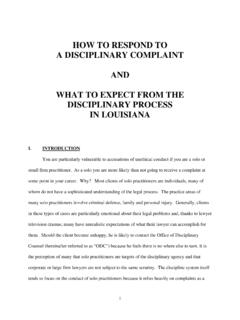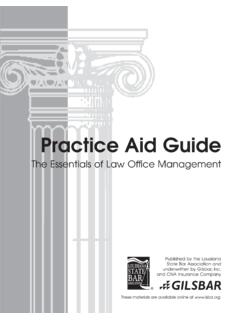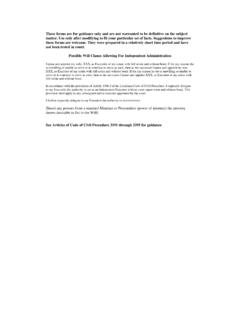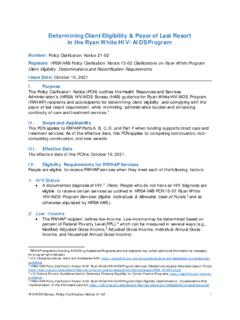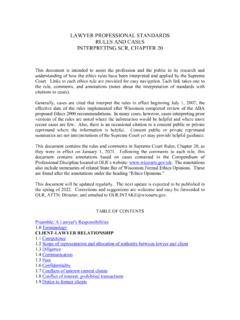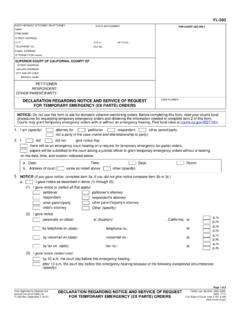Transcription of Termination of the Representation
1 SECTION 7. Termination of the Representation Mandatory Termination of Representation A lawyer may not represent a client, or where Representation has commenced, must withdraw from the Representation of a client, if: the Representation will result in violation of the Rules of Professional Conduct or other law;. the lawyer's physical or mental condition materially impairs her ability to represent the client;. the lawyer is discharged (see Rule (a) on page 91); or the lawyer has withdrawn from and/or terminated the Representation due to an actual or potential conflict of interest. Permissive Termination of Representation A lawyer is permitted to withdraw from Representation of a client, if withdrawal can be accomplished without material adverse effect on the client's interests, or if: the client persists in a course of action involving the lawyer's services that the lawyer reasonably believes is criminal or fraudulent.
2 The client has used the lawyer's services to perpetrate a crime or fraud;. the client insists upon taking action that the lawyer considers repugnant or with which the lawyer has a fundamental disagreement;. the client fails substantially to fulfill an obligation to the lawyer regarding the lawyer's services and has been given reasonable warning that the lawyer will withdraw unless the obligation is fulfilled;. the Representation will result in an unreasonable financial burden on the lawyer or has been rendered unreasonably difficult by the client; or other good cause for withdrawal exists. (Rule (b).) (See page 91.). Exceptions Nevertheless, a lawyer must continue Representation of a client notwithstanding good cause for terminating the Representation when ordered to do so by a tribunal.
3 (Rule (c).) (See page 92.). Also, a lawyer must comply with applicable law requiring notice to or permission of a tribunal when terminating a representa- tion. Other Reasons for Termination The Termination of Representation of a client may occur for several other reasons: the matter has been concluded by closure, settlement, judgment, appeal or dismissal. the client and the lawyer have mutually decided to terminate the Representation . 76 7. Termination OF THE Representation . Checklist for Termination of the Representation After the Representation for which you were retained has concluded, certain procedures should be undertaken in terminating the Representation : Take all steps which are reasonably practicable to protect the client's interests, such as giving reasonable notice of the withdrawal to the client, allowing time for employment of other counsel, surrendering papers and property to which the client is entitled, and refunding any advance payment of fee or expense that has not been earned.
4 (Rule (d).) (See page 92.). Ensure that you have complied with all applicable law, including local rules of court, before filing a motion to withdraw as counsel of record. Write the client a disengagement letter, signifying that the Representation has ended. See sample Disengagement Letters on pages 78-79. Review the file. Make sure all client documents are returned to the client. Purge the file of any redundant or duplicate materials. Calendar any future deadlines in the case, such as reinscription of a mortgage, revival of a judgment, etc. Prepare a file closing sheet. See sample form, Checklist for Closing Files, in the File Management Section on page 71. This form should be adapted for your particular practice.
5 This form also should be used to record vital information regarding client records and the client's file. Close the file. Generate a final invoice to the client. Return all client funds held in trust and any other property, including original documents, belonging to the client. You must keep complete records of any client funds held in a trust account and other property of a client for a period of five years after Termination of the Representation . (Rule (a).) (See page 89.). Client files should be retained for a minimum of five years after Termination of the Representation . [NOTE: There is a 10-year prescriptive period for attorney disciplinary violations and no prescriptive period applicable to the filing of a complaint against an attorney accused of fraudulent conduct.]
6 ]. The file is the property of the client, not the lawyer. Upon written request by the client, you must promptly release the entire file to the client or the client's new lawyer. You may retain a copy of the file, but may not condition its release over issues relating to the expense of copying the file or for any other reason, the most common of which is payment of fees or costs. (Rule (d).) (See page 92.). The responsibility for the cost of copying must be determined by the court in an appropriate proceeding. (Rule (d).). (See page 92.) In essence, this means that you must release the file first and pursue the client for the cost of copying it later. If you have recorded your contract or filed an intervention to protect your fees, and have been discharged without good cause, you may be entitled to recover the copying costs in that proceeding.
7 If you were discharged for cause, arguably you should bear the cost of copying the file which you seek to retain. In hourly fee cases, the contract should specify that the client will bear the copying costs in the event of Termination of the Representation . 7. Termination OF THE Representation 77. Sample Disengagement Letter (Non-Payment). June 20, 20 . Ms. Jane J. Former Client Certified mail. Return receipt requested. 123 Main Street Anytown, Louisiana 45678. RE: File Subject or Matter Description Dear Ms. Former Client: Thank you for allowing us to be of service in the above-captioned matter. As you know, our invoices have not been paid and are now more than 30 days past due. Therefore, as was explained at the outset of the engagement and in our written fee agreement, we must withdraw from representing you at this time.
8 We are enclosing a copy of the pleadings, correspondence and depositions taken in your case, as well as the original documents tendered to us during the Representation . You should contact other counsel immediately to further pursue (and protect) your interests in this matter. Your new counsel should have adequate time to serve your best interests, and you should provide your new counsel with your file for necessary review. A memorandum detailing the complete status of the matter with deadlines noted is attached. We regret that this action was necessary. Sincerely, FIRM NAME. Attorney Name Enclosures (as stated). [CAVEAT: Make sure any withdrawal/ Termination is in compliance with Rule of the Rules of Professional Con- duct.]
9 ]. 78 7. Termination OF THE Representation . Sample Disengagement Letter (Conclusion of Representation ). June 20, 20 . Ms. Jane J. Former Client 123 Main Street Anytown, Louisiana 45678. RE: File Subject or Matter Description Dear Ms. Former Client: [Win]. We are pleased to report that the judgment rendered in your favor is final and all legal delays have expired with no further action being taken by opposing counsel. Opposing counsel has confirmed to me in writing that his client has decided not to appeal the judgment; and a copy of that letter is enclosed for your file. Our Representation of you in this matter has come to an end. -or- [Loss]. As you have decided not to appeal the judge's decision in the captioned proceeding, our Representation of you in this matter has come to an end.
10 We are enclosing the following original documents: 1. Original insurance policy with XYZ Insurance Company, Policy No. 1235555;. 2. Multiple original of the Act of Cash Sale of your home at 123 Main Street;. 3. Original title insurance policy issued by Home Trust Title Insurance Company, Policy No. 006789; and 4. Copy of the abstract for your property dated May 3, 1996, prepared by Goodsearch, Inc. These documents should be kept in a safe place for future reference. Also enclosed is a final invoice for services rendered. Thank you for entrusting this legal matter to us. I hope we can be of service to you in the future. Sincerely, FIRM NAME. Attorney Name Enclosures (as stated). 7.



